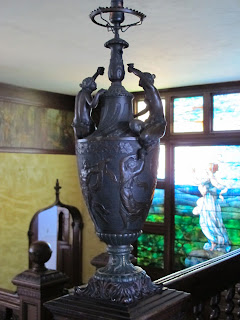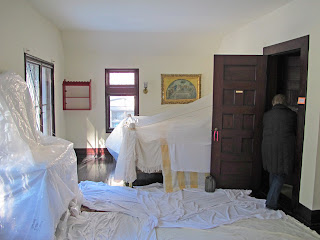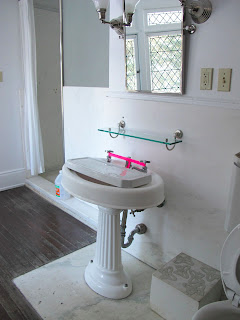
What's the worst thing in the world that can happen to a person? No, there's only one answer; losing a child. In December of 1875, financier Spencer Trask's wife Kate gave birth to a baby boy named Alanson. Little Alanson's sister Christina was born a year and a half after that. Eighteen months later Alanson Trask, age four, was dead of meningitis.
Partly as therapy, Trask and his wife bought a rundown mansion in the fashionable summer colony of Saratoga Springs, NY, and set about a major overhaul. Life appeared to sort itself out for a while. The Trasks liked Saratoga and in 1883 Kate had another baby, a boy named Spencer.
Then in April of 1888, little Spencer's sister Christina died of diphtheria, and three days after that, he died too. Spencer Trask Jr. was 5; his sister was 11. Undaunted, the parents kept trying and on August 17, 1889, they had their fourth child, a girl named Katrina. She died twelve days after birth. Eighteen months after that, in 1891, their Saratoga mansion burned to the ground.

Almost immediately Kate and Spencer decided (unexpectedly, I'd say) to replace the house with the palace in the photo above. The original building, oddly, was called "Yaddo," the word being Christina's childish mispronunciation of the word "shadow." OK, "Yaddo" comes from "shadow," but to me anyway, that doesn't explain much about the name. Yaddo's architect was William Halsey Wood, a Newark-based practitioner whose opus mixed a lot of barny Victorian manses with a great deal of ecclesiastical contracts. I've never heard of him. The new Yaddo was finished in 1893.
Spencer Trask (1844-1909) was a big time investment banker with half a dozen branch offices scattered across the northeast. His underwritings were prescient, profitable and profoundly influential. Neither The New York Times nor Con Edison, to name two important examples, would be here today without him.
Kate Nichols' 1874 marriage to Spencer Trask eventually gave her the leisure and financial freedom to become a poet. As Katrina Trask, she was published and profiled and much better known in her lifetime than she is today. She is described by some sources as a "Pre-Rafaelite figure," the reference being to the influential group of English painters and poets that provoked many a tempest in the overheated world of 19th century morals and aesthetics. I don't know about Kate, but as Katrina she had a consistent penchant for gauzy dresses and Arthurian subject matter.

The Trasks entertained on a big scale, which I've always found an attractive trait. The new Yaddo, not built for family or children, was designed instead for the elaborate entertainment of a very wide circle of literary and artistic types. Yaddo under the Trasks was pretty much a continuous house party attended by guests chosen for their intellect and conversation. The gate in the vintage image below is gone - one more Department of Transportation victim - but other gates survive. This is what the drive to the house looks like today.





The Yaddo Corporation has operated the estate as an application-based retreat for artists and writers since 1926. Guests stay in various buildings 12 months a year, but the mansion itself is only partly heated in the winter. The dining room and former servants' hall are warm; the rest of the place is colder than my house, so be prepared.

It's winter and everything's covered with shrouds and bags, which doesn't dim the overall magnificence of the place. I love to kid in my column, and while the Trasks are not good subjects for kidding, the sliver of Tiffany window visible at the left of the image below is too tempting. It is a depiction of Katrina's story in verse of Winnapoca and Minneo, the details of which we can guess without the docent's explanation. Massafrawia stands alone on the left, while at center stage Ottawawa bears a maiden tenderly in his arms, all three under the gaze of the great chief Winnapoco. I wish she'd made those names up and am only sorry she didn't.

The Great Hall is big enough for the large entertainments that often took place there. At Yaddo's 1893 housewarming there were 400 guests.



My guide, Leslie Leduc, is bundled up against the February cold - indoors. The newels at the foot of the stair are topped with bronze statues of Mercury and Prometheus, alas both wrapped for the winter in plastic garbage bags. A great deal of the art and furniture that originally decorated the house is still in situ, like the portraits of Spencer and Katrina, painted in their 50s - Spencer in costume; Katrina maybe not - by an Hungarian named Arthur von Ferraris.



The obligatory reception room opposite the main stair is not overly interesting. The combination library/drawing room at the south end of the Great Hall is another matter.


There's desultory talk hereabouts that compares Yaddo to Haddon Hall in the UK. Save for the million-mullion windows, I'd call that a stretch. How great is that old overstuffed furniture with the fringed skirting? I have a couple of chairs like that, pensioners from Tuxedo Park, still in good condition by virtue of sitting in a room rarely frequented by my cat.

The pews under plastic were purpose built for theatricals that even in early days were staged in what is now called the Music Room. The bronze medallion in the middle of the fireplace is Mrs. Trask's second husband, George Foster Peabody, about whom more later.




On the library wall are portraits of Spencer and Christina Trask, painted (probably posthumously) the year they died, 1888, by Eastman Johnson.


The dining room has heat!



Some husbands treat their wives like queens; Spencer Trask actually crowned his. In the fall of 1882, in the middle of an enormous Halloween party, wife Kate found herself the object of a schmaltzy ceremony proclaiming her "Katrina Regina, Queen of Yaddo." She blushed at the fuss, but kept the name. One of the few pieces of fake anything at Yaddo is her crown, which resides today inside a dining room vitrine.

Through the swing door, beyond a serving pantry, is the conveniently located kitchen - "conveniently" meaning it's not in the basement. Pantry cabinets and marble wall panels are pretty much intact, however, the kitchen itself has been institutionalized.





Guests at Yaddo are called to table by original dinner chimes.

Among assorted staff rooms beyond the kitchen are a powder room (couldn't miss that), a surprisingly large and comfortable servants' hall (now a cold weather guest lounge complete with fireplace), and the old servants' dining hall with original built-in buffet.



Head chef Mike Hazard (right) and assistant Pete Kennedy plan meals in consultation with Mr. Trask, in chef's hat.


Time to go upstairs.



The Trasks slept in separate bedrooms. Nothing unusual about that, then or now. At Yaddo, however, where everything is big, these rooms were parts of suites the size of four and a half room Manhattan apartments. Spencer Trask's "Arts and Crafts" bedroom suite is located north of the first stair landing, over the porte cochere. The door with the gorgeous hinges and amazing latch mechanism leads to an exterior stair to the drive.





Leslie is posing in front of Mr. Trask's bed, located in a roomy alcove. On New Year's Eve, 1909, Trask set out by rail from Saratoga to New York. In the manner of the day, his private car was attached to the end of a scheduled train, in this case the Montreal Express. Arctic temperatures that day stalled a train south of Croton causing the Express to stop. A fast freight rounded a bend, following green signals according to its engineer, and plowed at high speed into the rear of the Express, crushing Trask's car and killing him in the process. Miraculously, no one else was hurt. Both engineers were arrested. Trask was 65 years old.


Another run of stairs leads from the level of Spencer Trask's suite to the main part of the second floor. At the north end of another grand hallway is a sleeping porch. Mrs. Trask's suite is at the hall's southern end.





The footprint of Katrina Trask's bedroom is the size of some houses. She and her husband had decided back in 1900 that Yaddo would eventually become an artists' retreat. "Some....will drink of the Fountain of Hippocrene," she wrote of her future guests. (In case you forgot, Hippocrene was a spring at the foot of Mt. Helicon, whose waters inspired the muses). "(A)nd all of them," she added, typically, "will find the Sacred Fire and light their torches at its flame." The rose, seen in stained glass below, was Katrina's personal symbol. After her husband's death she closed Yaddo and moved to the former farm superintendent's cottage, supposedly to save money for the future retreat.



A largely intact bath and dressing room, plus a boudoir, make up the rest of Katrina's suite.


Principal guest rooms, together with fabulous old baths, line a corridor extending west from the main hall.







The stair in the image below goes to the third floor. We'll postpone that trip for a moment and head instead a few steps down to the servants' library. The servants' "what," you say? Just as Starbucks calls its counterpeople "barristas" and the guy in the blue shirt at Best Buy is an "associate," so Katrina Trask disliked the whole idea of "servants." She avoided using the word at all and - talk about actions speaking louder than words - accommodated her in-house staff at a level of comfort I've never seen in any other big old house.


The presence of an annunciator on the wall is the only reason you'd know this was the servants' wing. The library nook, the lounge with fireplace, the big sunny rooms, and the luxurious bathrooms - certainly luxurious by 1893 standards, and even so today - could just as well be for family or guests.







A secondary stair located back in the main hall, leads not just to the third floor, but to Katrina's fourth floor studio. The studio is the room with the vintage picture window at the top of Yaddo's central stone tower.




The third floor below the studio contains broad corridors and sunny bedrooms, some of which are unexpectedly elaborate.




Time to head down and warm up in the dining room.



On the right in the vintage photo below, snapped on the porch of the old Yaddo, is the celebrated American artist Eastman Johnson (1824-1906), known in his day as the American Rembrandt. A founder of the Metropolitan Museum of Art, Johnson painted Katrina's late children and Katrina herself. The man on the left, at whom Katrina is gazing rather fixedly, is George Foster Peabody (1852-1938), her husband's business partner, first president of the Yaddo Corporation, confidant of FDR, namesake of broadcast journalism's Peabody Awards, and Katrina's second husband. Peabody carried a torch for her for years, managing finally to marry her nine months before she died in 1922.

Nearly 6000 "guests" - in the fields of literature, painting, film, performance art, choreography, photography, musical composition, sculpture, video and print making - have "nurtured the creative process" at Yaddo since it officially opened in 1926. That works out to about 220 visiting guests per year, each of whom stays either in the mansion or one of the outlying studios for an average of 5 weeks. Truman Capote, Flannery O'Connor, William Carlos Williams, Robert Lowell, Sylvia Plath, Philip Roth, Amy Tan, Langston Hughes, Aaron Copeland, James Baldwin, Mario Puzo - I'm running out of breath - are all Yaddo veterans. As a group, they have pulled down 66 Pulitzer Prizes, 5 Academy Awards, 68 National Book Awards, 456 Guggenheim Fellowships...I have to stop somewhere, so let's make it here. It's not just art that has been high at Yaddo. John Cheever bragged that he got laid on every flat surface in the house. (He said it, not me). When it came to the beat generation of the 1950s, however, long time director Elizabeth Ames put her foot down. Henry Miller was blackballed; Allen Ginzberg wouldn't have got through the front door.

It costs nothing to stay at Yaddo - discounting the psychic cost of sweating the application process. Corporations, foundations, generous individuals and an endowment - albeit one in constant need of replenishment - fund an annual budget of a little under $3 million. Yaddo Corp. is a remarkable legacy, not to mention an amazing old house. I'd like to thank my hosts for use of vintage photos from the Yaddo archives, and note that although the mansion is off limits to all but invited guests, the adjacent gardens are open to the public. The link is www.yaddo.org.